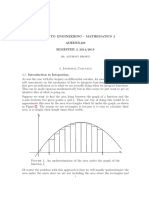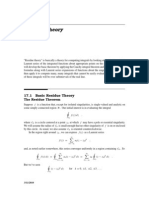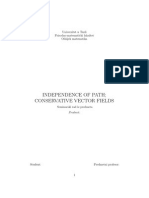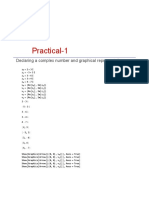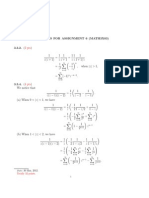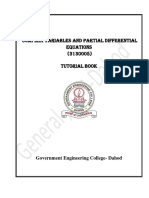Fresnel Integrals
Fresnel Integrals
Uploaded by
최재혁Copyright:
Available Formats
Fresnel Integrals
Fresnel Integrals
Uploaded by
최재혁Copyright
Available Formats
Share this document
Did you find this document useful?
Is this content inappropriate?
Copyright:
Available Formats
Fresnel Integrals
Fresnel Integrals
Uploaded by
최재혁Copyright:
Available Formats
Fresnel Integrals
David Sirajuddin
Itcanbeshown.com
May 29, 2008
The following integral
_
0
cos x
2
dx (1)
can be evaluated by way of complex calculus (see An Engineers Guide to Complex Integra-
tion). At rst, the problem can prove dicult due to the odd choice of complex contour one
must use in order to obtain a solution. This integral is known as a Fresnel integral and arises
in the eld of optics in the description of near eld Fresnel diraction. While the function
is transcendental when evaluating the integral over denite limits, a solution can be found
when the bounds are treated as semi-innite. In fact, the convergence of the real integral
over semi-innite bounds is suggested when looking at a trace of the function (Figure 1).
Figure 1 - A plot is shown of the Fresnel cosine function. The frequency increases with x.
As evident from above, the frequency of the function increases with x, until the wavelength
of the function tends to zero as x . The function oscillates above and below the x-axis,
suggesting that it is possible in the limit for large x, that sucient contributions from the
area sweeped out by the function will be cancelled out by its negative and positive portions,
leading to a nite result. This is precisely the case, and this nite value of the integral is
found via complex integration.
1
Sirajuddin, David Fresnel Integrals
The real-valued function f(x) = cos x
2
is transposed into the complex domain as a
complex exponential f(z) = exp(iz
2
). The complex function f is identied to hold no
singularities; however, this only suggests that the complex closed contour integral of this
function about any domain is zero, not that all path integrals making up the closed contour
are themselves zero. Thus, a solution could still be obtained in this manner. In order
to choose a proper contour, begin by examining the behavior of the complex exponential
function in the complex plane, this is qualitatively shown in the gure below:
Figure 2 - The behavior of the function e
iz
2
is examined. In (a) the function is described along a positively
oriented closed circular contour. The regions where the function decays and increases are labelled. In (b), a
proposed quarter circle contour is shown that evades the increasing regions of the function. And, in (c) an
eighth circle is given, which is a contour that allows for the integration to yield a proper, nite value.
It is seen by inspection that, when examined along a positively oriented closed circular con-
tour, the complex exponential function exp(iz
2
) increases and decays in dierent quadrants.
The integral of the function in a region of growth is not capable of admitting a nite result
since the limits of integration (and hence the radius of any circular path) must eventually be
extended to innity in accordance with the original problem. However, it would seem that
it is still possible to integrate, so long as the increasing regions of the function are avoided.
Thus, a rst choice of contour could be the quarter-circle illustrated in Figure 2(b). However,
when choosing this contour, applying residue theorem, and taking limits, the solution to the
problem does not yield a value, but rather an identity:
_
0
cos x
2
dx =
_
0
sin x
2
dx (2)
This is certainly nice to know, but a value of both these functions integrated over the
stipulated limits is still yet to be found. In order to integrate the function over the desired
bounds so as to obtain a nite result, the 1/8th circle, shown in Figure 5(c), is used.
Applying residue theorem to the system provides the following statement
2
Sirajuddin, David Fresnel Integrals
_
C
e
iz
2
dz = 0
where C is used to denote the closed contour shown in Figure 2(c). Notice how since there
are no residues contained within the contour, the contour integral of the function is equal
to zero. That is to say, residue theorem is reduced to Cauchys integral theorem in this
instance. The integral can further be broken up into a summation of path integrals, where
the sum of the paths is equivalent to the contour C.
_
C
1
e
iz
2
dz
. .
I
+
_
C
2
e
iz
2
dz
. .
II
_
C
3
e
iz
2
dz
. .
III
= 0 (3)
The integrals have been labelled as I, II, and III for convenient referencing, and each path
C
1
, C
2
, and C
3
are as shown in Figure 5(c). Each integral is evaluated below.
Integral I
The only work that needs to be done on this integral is to parameterize it along the real
line, and take limits. Thus,
_
C
1
e
iz
2
dz =
_
R
0
e
ix
2
dx
since f(z) = f(x, y), and y = 0 for all points on the real line. Letting R , Integral I
becomes
_
0
e
ix
2
dx. (4)
where it is noted that the real part of this integral can be taken to make this equation of the
same form as the original integral in the problem statement (Eqn. (4)).
Integral II
Since integral II has a complex-valued, nonconstant path, it would be convenient to prove
this integral tends to zero. This integral does indeed turn out to be identical to zero, by
way of Jordans lemma. This is shown by initially factoring the function in the integrand in
the following way
_
C
2
e
iz
2
dz =
_
C
2
e
i(z
2
z)
e
iz
dz =
_
C
2
g(z)e
iz
dz.
The above equation is now in the form of the statement in Jordans lemma, where g(z) =
e
iz(z1)
. Since the function g is entire, that is, it is analytic for all points in the complex
plane, it meets the requirements for Jordans lemma. Thus, it can be said that
_
C
2
e
iz
2
dz = 0 (5)
3
Sirajuddin, David Fresnel Integrals
Integral III
For the third integral, the following parametrization is introduced
z(t) = e
i(/4)t
=
1 + i
2
t (0 t t
0
)
it then follows that
dz =
1 + i
2
dt
for an appropriate value of t
0
, such that dist|0, z(t
0
)| = R. Inputting these substitutions into
integral III in Eqn. (3)
_
C
3
e
iz
2
dz =
1 + i
2
_
t
0
0
exp
_
i
_
e
i
4
t
_
2
_
dt
=
1 + i
2
_
t
0
0
exp
_
i
_
e
i
4
t
2
_
2
_
dt
=
1 + i
2
_
t
0
0
exp(i
2
t
2
)dt
=
1 + i
2
_
t
0
0
e
t
2
dt
Furthermore, if t
0
is allowed to extend to innity then
_
C
3
e
iz
2
dz =
1 + i
2
_
0
e
t
2
dt
The parametrization has rendered the original integral into a Gaussian integral. The above
integral can be evaluated in a number of ways. Such methods include Feynmanns so-called
parametric integration, or by integrating the square of the integral in polar coordinates, or
by using the gamma function (t). It is identied that the integral above is equivalent to
(3/2) =
/2. Thus, the solution to the above equation can be written as
1 + i
2
_
0
e
t
2
dt =
_
1 + i
2
_
2
=
1
2
_
2
+
i
2
_
2
(6)
Inserting Eqns. (4), (5), and (6) into (3), and solving for the real integral reveals
_
0
e
ix
2
dx =
1
2
_
2
+
i
2
_
2
Taking the real part of the above equation, and combining this result with the identity shown
in Eqn. (2), the solution to integral (1) is found to be
_
0
cos x
2
dx =
_
0
sin x
2
dx =
1
2
_
2
(7)
4
You might also like
- Useful Definite Integrals: Appendix CDocument4 pagesUseful Definite Integrals: Appendix CmaximilianodemasiNo ratings yet
- MATH A2Document4 pagesMATH A2ThabangNo ratings yet
- Semester 1Document44 pagesSemester 1Tom DavisNo ratings yet
- Improper Integrals Involving Rational and Exponential Functions PDFDocument10 pagesImproper Integrals Involving Rational and Exponential Functions PDFhammoudeh13No ratings yet
- Mcmain SolidsofrevolutionDocument15 pagesMcmain Solidsofrevolutionapi-280902734No ratings yet
- Function Generation Using Freudenstein's EquationDocument15 pagesFunction Generation Using Freudenstein's Equationvenkatanaveen306No ratings yet
- Complex NumbersDocument11 pagesComplex NumbersOmkar SawantNo ratings yet
- Integral CalculusDocument8 pagesIntegral Calculussergio bautistaNo ratings yet
- Lagrange Multipliers Can Fail To Determine Extrema: AcknowledgmentDocument3 pagesLagrange Multipliers Can Fail To Determine Extrema: Acknowledgmentarvind lakshmi ranjan100% (2)
- Sec3 PDFDocument12 pagesSec3 PDFRaouf BouchoukNo ratings yet
- Handout Residue TheoremDocument4 pagesHandout Residue TheoremGabo del NorteNo ratings yet
- ttp12 015Document21 pagesttp12 015cchenNo ratings yet
- Lecture Notes For MA5NO Cohomology, Connections, Curvature and Characteristic ClassesDocument66 pagesLecture Notes For MA5NO Cohomology, Connections, Curvature and Characteristic ClassesSrinivas RauNo ratings yet
- Math Integration 1DDocument7 pagesMath Integration 1Dమత్సా చంద్ర శేఖర్No ratings yet
- Some Useful Integrals of Exponential Functions: Michael FowlerDocument6 pagesSome Useful Integrals of Exponential Functions: Michael FowlerSunny HungNo ratings yet
- Math Signature Assignment 2Document6 pagesMath Signature Assignment 2api-245099625No ratings yet
- The Cube Roots of Unity: David Arnold February 25, 2003Document16 pagesThe Cube Roots of Unity: David Arnold February 25, 2003Rituraj BoruahNo ratings yet
- Math 322 Notes 2 Introduction To FunctionsDocument7 pagesMath 322 Notes 2 Introduction To Functions09polkmnpolkmnNo ratings yet
- Integral CalculusDocument25 pagesIntegral CalculusLiregine CaymeNo ratings yet
- H-Infinity Norm For Sparse VectorsDocument15 pagesH-Infinity Norm For Sparse VectorsPriyanka Jantre-GawateNo ratings yet
- 13 6 Integrtn Trig FunctnsDocument15 pages13 6 Integrtn Trig FunctnsDaniel SHNo ratings yet
- 07 01 Integration IntroDocument17 pages07 01 Integration IntroJohn Bofarull GuixNo ratings yet
- Module 13 - Differential Equations 3 (Self Study)Document4 pagesModule 13 - Differential Equations 3 (Self Study)api-3827096No ratings yet
- Dosang Joe and Hyungju Park: Nal Varieties. Rational Parametrizations of The Irreducible ComponentsDocument12 pagesDosang Joe and Hyungju Park: Nal Varieties. Rational Parametrizations of The Irreducible ComponentsMohammad Mofeez AlamNo ratings yet
- FPE6e Appendices WDEFGDocument27 pagesFPE6e Appendices WDEFGSami SyedNo ratings yet
- BITSAT 2023 Paper Memory BasedDocument19 pagesBITSAT 2023 Paper Memory Basedkrishbhatia1503No ratings yet
- Chap 12Document22 pagesChap 12Hadi HassanNo ratings yet
- September 1, 2017, Magne Nordaas, Matematiska Vetenskaper, Chalmers Tekniska H OgskolaDocument8 pagesSeptember 1, 2017, Magne Nordaas, Matematiska Vetenskaper, Chalmers Tekniska H OgskolaAdán LópezNo ratings yet
- Function Parametric and Implicit FormDocument25 pagesFunction Parametric and Implicit FormUmberto ManzaliniNo ratings yet
- Many Cheerful FactsDocument17 pagesMany Cheerful Factsbobmiller94No ratings yet
- Evaluation of FourierDocument5 pagesEvaluation of FourierVivek KumarNo ratings yet
- 12 Math Notes chpv8Document17 pages12 Math Notes chpv8Shah KavishNo ratings yet
- Primer 4Document9 pagesPrimer 4rahim.sihadjmohandNo ratings yet
- Anti DerivativesDocument21 pagesAnti DerivativesHanna GalatiNo ratings yet
- Wavelets 3Document29 pagesWavelets 3ac.diogo487No ratings yet
- Variables or Real Multivariate Function Is A Function With More Than One Argument, With AllDocument8 pagesVariables or Real Multivariate Function Is A Function With More Than One Argument, With AllMhalyn Üü NapuliNo ratings yet
- Integral CalculusDocument22 pagesIntegral CalculusJonas PhiriNo ratings yet
- Mathematical Prerequisites: 1.1 Operations On Complex NumbersDocument6 pagesMathematical Prerequisites: 1.1 Operations On Complex NumbersDennis Mads MakhandiaNo ratings yet
- fractionalCalculusMinorThesis PDFDocument98 pagesfractionalCalculusMinorThesis PDFWalaa AltamimiNo ratings yet
- Visualizing Techniques of IntegrationDocument21 pagesVisualizing Techniques of Integrationkaushik247No ratings yet
- Comples Notes 1: Abhishake Sadhukhan Conformal TransformationsDocument3 pagesComples Notes 1: Abhishake Sadhukhan Conformal TransformationsSourav RoyNo ratings yet
- Cylindrical Algebraic Decomposition - An IntroductionDocument40 pagesCylindrical Algebraic Decomposition - An IntroductionMario CacasennoNo ratings yet
- Module 3 Numerical IntegrationDocument10 pagesModule 3 Numerical IntegrationHarsh KumarNo ratings yet
- A New Index Calculus Algorithm With Complexity L (1/4 + o (1) ) in Small CharacteristicDocument23 pagesA New Index Calculus Algorithm With Complexity L (1/4 + o (1) ) in Small Characteristicawais04No ratings yet
- Theoretical Physics: Course Codes: Phys2325/Phys3150Document36 pagesTheoretical Physics: Course Codes: Phys2325/Phys3150Raghav AgrawalNo ratings yet
- Comparing Riemann and Monte Carlo ApproximationDocument8 pagesComparing Riemann and Monte Carlo ApproximationryanfieldNo ratings yet
- 17.1 Basic Residue TheoryDocument27 pages17.1 Basic Residue Theoryleo ssantanaNo ratings yet
- Further Trig ContentsDocument23 pagesFurther Trig ContentsHomework HelperNo ratings yet
- Third Geometric Note On S-ConvexityDocument12 pagesThird Geometric Note On S-Convexitymarcia_pinheiro_2No ratings yet
- Integration Bảo TàiDocument37 pagesIntegration Bảo TàiKhánh Hưng Lê VănNo ratings yet
- Independence of Path and Conservative Vector FieldsDocument39 pagesIndependence of Path and Conservative Vector FieldsIsmailĐedovićNo ratings yet
- ME5110 Grid GenerationDocument10 pagesME5110 Grid GenerationlakiizNo ratings yet
- Guruji Takes Gaitonde For RideDocument5 pagesGuruji Takes Gaitonde For RideRidhi KhuranaNo ratings yet
- Integration of Trigonometric FunctionsDocument13 pagesIntegration of Trigonometric FunctionsJohnNo ratings yet
- A-level Maths Revision: Cheeky Revision ShortcutsFrom EverandA-level Maths Revision: Cheeky Revision ShortcutsRating: 3.5 out of 5 stars3.5/5 (8)
- MTHDocument6 pagesMTHPraneeth SaiNo ratings yet
- Complex Variables With Applications GBVDocument5 pagesComplex Variables With Applications GBVmuyiNo ratings yet
- ) Cos, (Sin: 6.4 Consider Integrals of The FormDocument15 pages) Cos, (Sin: 6.4 Consider Integrals of The FormAmmar AjmalNo ratings yet
- R23 II Year Syllabus EEEDocument43 pagesR23 II Year Syllabus EEEjayajanjam55566No ratings yet
- Z-Transforms: Definition: The - Transform of A SequenceDocument15 pagesZ-Transforms: Definition: The - Transform of A SequenceSudhir RavipudiNo ratings yet
- Asfak Sakil Khan 17/1232Document49 pagesAsfak Sakil Khan 17/1232Asfak Sakil KhanNo ratings yet
- Mat201, University Questions With SolutionsDocument30 pagesMat201, University Questions With Solutionssreehari14shrNo ratings yet
- 3 The Calculus of ResiduesDocument35 pages3 The Calculus of Residuesmaurizio.desio4992No ratings yet
- Lecture Notes: Find Courses About Give Now Featured SitesDocument2 pagesLecture Notes: Find Courses About Give Now Featured SitesJaneNo ratings yet
- Math 121A: Homework 9 Solutions: I Z Z Z ZDocument3 pagesMath 121A: Homework 9 Solutions: I Z Z Z ZcfisicasterNo ratings yet
- Solu 6Document3 pagesSolu 6nikolaimuthamaNo ratings yet
- AKTU 1st Yr 2Document48 pagesAKTU 1st Yr 2pthimanshuNo ratings yet
- Lecture Complex Variable - Residue Theorem CSE 201Document46 pagesLecture Complex Variable - Residue Theorem CSE 201mdjakir.jr05No ratings yet
- IMP Harvard PDFDocument140 pagesIMP Harvard PDFTalha MirNo ratings yet
- Complex Variable PDFDocument4 pagesComplex Variable PDFZain Mirxa ChughtaiNo ratings yet
- MathematikDocument1 pageMathematikpocius.arturNo ratings yet
- Textile TechnologyDocument80 pagesTextile TechnologyJagan KumarNo ratings yet
- Craig NoteDocument226 pagesCraig NoteMd. Tanvir HossainNo ratings yet
- Math II 2 - MarksDocument50 pagesMath II 2 - MarksMus'ab UsmanNo ratings yet
- Lesson Plan Sem 3Document35 pagesLesson Plan Sem 3narayananx5No ratings yet
- Problem 1: Unit Iv Complex Integration Part-ADocument19 pagesProblem 1: Unit Iv Complex Integration Part-ASachin MalikNo ratings yet
- Course Outline of ComplexDocument3 pagesCourse Outline of ComplexTehreem AyazNo ratings yet
- Complex1 PDFDocument14 pagesComplex1 PDFKrish Pavan100% (1)
- Calculus of ResiduesDocument19 pagesCalculus of ResiduesNa JidNo ratings yet
- Tutorial - CVPD - 2019 202019 12 18 13 01 50Document77 pagesTutorial - CVPD - 2019 202019 12 18 13 01 50mohammmadkaish12No ratings yet
- Cvpde - Compressed TheoryDocument36 pagesCvpde - Compressed TheoryChavda Rohit0% (1)
- Syllabus of MSC Mathematics CUJDocument30 pagesSyllabus of MSC Mathematics CUJAkash GartiaNo ratings yet
- Chapter 4Document23 pagesChapter 4jeff_hammonds351No ratings yet
- Notes MathsDocument156 pagesNotes MathsNitendra KumarNo ratings yet
- (9783110409475 - Mathematics For The Physical Sciences) Mathematics For The Physical Sciences PDFDocument445 pages(9783110409475 - Mathematics For The Physical Sciences) Mathematics For The Physical Sciences PDFalucard dracula100% (1)




































